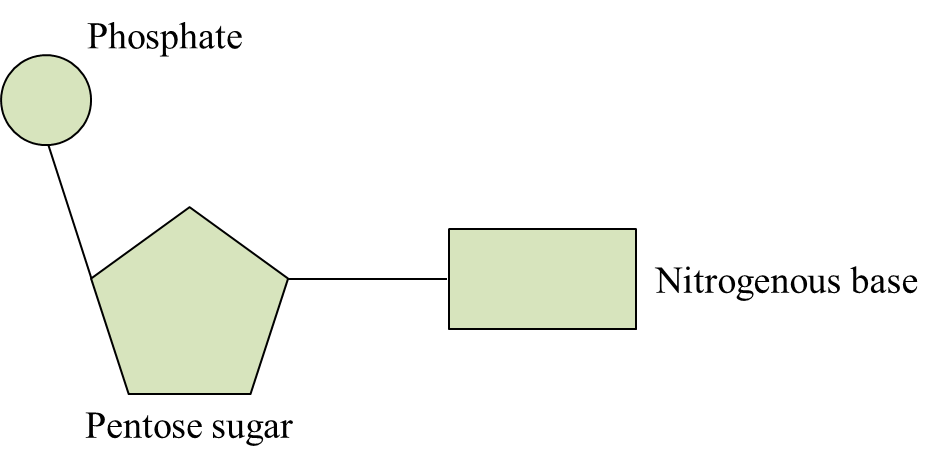[adinserter block="3"]
Question 1:
Diagram 1.1 shows the structure of a plant cell.
 Diagram 1.1
Diagram 1.1
(a) Name the structures C and D. [2 marks]
(b)(i) State the component which forms structure C. [1 mark]
(b)(ii) Draw and label the basic unit structure of the main component which is named in 1(b)(i). [2 marks]
(c) The cell in Diagram 1.1 is immersed in distilled water for an hour.
(i) Explain what will happen to the structure B. [3 marks]
(ii) Explain why the cell does not burst. [2 marks]
[adinserter block="3"]
(d) Diagram 1.2 shows two examples of tissues in plants.
 Diagram 1.2
Diagram 1.2
Based on Diagram 1.2, state a characteristic of each tissue.
(i) Meristematic tissue:
(ii) Collenchyma tissue: [2 marks]
[adinserter block="3"]
Answer:
(a)
C : Chromosome / Chromatin
D : Rough endoplasmic reticulum
(b)(i)
Deoxyribonucleic acid (DNA)
(b)(ii)

[adinserter block="3"]
(c)(i)
Structure B (vacuole) will swell or increase in size.
- The vacuole contains cell sap which is hypertonic (to distilled water).
- Water molecules diffuse into the cell by osmosis and fill the vacuole causing it to swell.
(c)(ii)
- Plant cells are surrounded by a strong and rigid cell wall.
- Cell wall is able to withstand the strong turgor / hydrostatic pressure that develops within the cell.
(d)(i)
- Small-sized cells
- Dense cytoplasm / lack of vacuoles
- Large nucleus / nucleus at various stage of division / mitosis
- Undifferentiated cell
(Any one of the characteristics)
(d)(ii)
- Cell wall is not uniformly thickened
- Corners of cell have thicker cell wall
(Any one of the characteristics)
Diagram 1.1 shows the structure of a plant cell.
 Diagram 1.1
Diagram 1.1 (a) Name the structures C and D. [2 marks]
(b)(i) State the component which forms structure C. [1 mark]
(b)(ii) Draw and label the basic unit structure of the main component which is named in 1(b)(i). [2 marks]
(c) The cell in Diagram 1.1 is immersed in distilled water for an hour.
(i) Explain what will happen to the structure B. [3 marks]
(ii) Explain why the cell does not burst. [2 marks]
[adinserter block="3"]
(d) Diagram 1.2 shows two examples of tissues in plants.
 Diagram 1.2
Diagram 1.2 Based on Diagram 1.2, state a characteristic of each tissue.
(i) Meristematic tissue:
(ii) Collenchyma tissue: [2 marks]
[adinserter block="3"]
Answer:
(a)
C : Chromosome / Chromatin
D : Rough endoplasmic reticulum
(b)(i)
Deoxyribonucleic acid (DNA)
(b)(ii)

[adinserter block="3"]
(c)(i)
Structure B (vacuole) will swell or increase in size.
- The vacuole contains cell sap which is hypertonic (to distilled water).
- Water molecules diffuse into the cell by osmosis and fill the vacuole causing it to swell.
(c)(ii)
- Plant cells are surrounded by a strong and rigid cell wall.
- Cell wall is able to withstand the strong turgor / hydrostatic pressure that develops within the cell.
(d)(i)
- Small-sized cells
- Dense cytoplasm / lack of vacuoles
- Large nucleus / nucleus at various stage of division / mitosis
- Undifferentiated cell
(Any one of the characteristics)
(d)(ii)
- Cell wall is not uniformly thickened
- Corners of cell have thicker cell wall
(Any one of the characteristics)
[adinserter block="3"]
Question 2:
Diagram 2.1 shows the foods which contain carbohydrates.
 Diagram 2.1
Diagram 2.1
(a)(i) Based on diagram 2.1, name the type of carbohydrates in rice and honey. [2 marks]
(a)(ii) Explain why diabetic patients are advised not to consume excessive amount of rice in their daily diet. [3 marks]
(b) Diagram 2.2 shows the formation of molecule R in milk.
 Diagram 2.2
Diagram 2.2
Based on the diagram 2.2, describe:
(i) the formation of molecule R. [2 marks]
(ii) the breakdown of molecule R. [2 marks]
(c) When sucrose solution is heated with Benedict’s solution, the blue solution remains unchanged.
Explain why Benedict’s test gives negative result on sucrose. [3 marks]
[adinserter block="3"]
Answer:
(a)(i)
Rice : Starch
Honey : Fructose / glucose / sucrose
Diagram 2.1 shows the foods which contain carbohydrates.
 Diagram 2.1
Diagram 2.1 (a)(i) Based on diagram 2.1, name the type of carbohydrates in rice and honey. [2 marks]
(a)(ii) Explain why diabetic patients are advised not to consume excessive amount of rice in their daily diet. [3 marks]
(b) Diagram 2.2 shows the formation of molecule R in milk.
 Diagram 2.2
Diagram 2.2Based on the diagram 2.2, describe:
(i) the formation of molecule R. [2 marks]
(ii) the breakdown of molecule R. [2 marks]
(c) When sucrose solution is heated with Benedict’s solution, the blue solution remains unchanged.
Explain why Benedict’s test gives negative result on sucrose. [3 marks]
[adinserter block="3"]
Answer:
(a)(i)
Rice : Starch
Honey : Fructose / glucose / sucrose
(a)(ii)
- When rice is completely digested, it produces glucose.
- Diabetic patients lack / produce lower amount of insulin hormone.
- They are unable to convert excessive glucose into glycogen, hence the higher concentration of glucose in blood.
(b)(i)
- Molecule R is disaccharide.
- It is formed when two molecules of monosaccharide are linked together by condensation reaction / with the loss of water molecule.
(b)(ii)
- Molecule R is hydrolysed / digested by the addition of a water molecule by an enzyme.
- To form its component monosaccharides / P and Q.
(c)
- Sucrose is non-reducing sugar.
- Sucrose unable to reduce the blue copper (II) ions / Cu2+ (aq) in Benedict’s solution.
- Red copper (I) ions / Cu+ (aq) are not produced / formed.